One year when we were children, my brother and I were each given a set of badminton racquets for Christmas. We never really took much interest in badminton. But those racquets turned out to be excellent white cabbage butterfly (Pieris rapae) swatters.
We’d run – sometimes bike – around the neighbourhood, swatting at every butterfly we saw.
We were trained to dispise them. They’d lay eggs which would hatch into nasty green caterpillars. The caterpillars would eat our food and leave their gross green poos (the scientists call this ‘frass’) in our cabbages.
Eventually those caterpillars would turn into the white cabbage butterflies we were running around smashing with our friends and our badminton racquets.
White cabbage butterfly is something I get a lot of questions about. People want to know how to get rid of them, or avoid the damage they do in the garden.
So today we’re going to take a Deep Dive – into their lifecycle, preferred foods, things they (reportedly) can’t stand, and – of course – how to smash them (without the badminton racquet!)
History of white cabbage butterfly
White cabbage butterfly (Pieris rapae) – known in other parts of the world as the cabbage white, or cabbage butterfly – is not native to New Zealand. It was first recognised here in the Hawkes Bay in 1929.
They are native to Asia and Europe. Within 5 years of their introduction, they had established throughout the country and become the pest we know today.
Did you know?
There’s more than one type of white butterfly! There’s also the Great White Butterfly (Pieris brassicae). It was first identified in New Zealand in 2010 near Nelson. It is thought to have arrived as pupae on goods shipped into the city’s port.
In 2012, the Department of Conservation – concerned for our 79 native cress plant species – took action to eradicate it. They were joined by the Ministry of Primary Industries (MPI), Horticulture New Zealand, AgResearch and Plant and Food Research.
In late 2016, it was announced that eradication had been successful. But it’s important to be vigilant because they could always arrive again.
Visit the Department of Conservation’s webpage on the Great White Butterfly to learn what to look for and how to report it if you find them in your garden.
Lifecycle
“If you know the enemy and know yourself, you need not fear the result of a hundred battles. If you know yourself but not the enemy, for every victory gained you will also suffer a defeat. If you know neither the enemy nor yourself, you will succumb in every battle.”
Each year between spring and autumn, there are between three and five generations of white cabbage butterfly. Let’s look at the lifecycle, so we know what we’re up against.
If you want to follow this lifecycle in more depth (perhaps with your children), SciLearnHub have developed an activity you’ll be able to do from your own garden.
Follow this link and scroll to the bottom of the page. Download the Word file.
Egg
The female butterfly lays eggs on the undersides of brassica leaves. White cabbage butterfly eggs are about 1mm long, and a bullet shape.
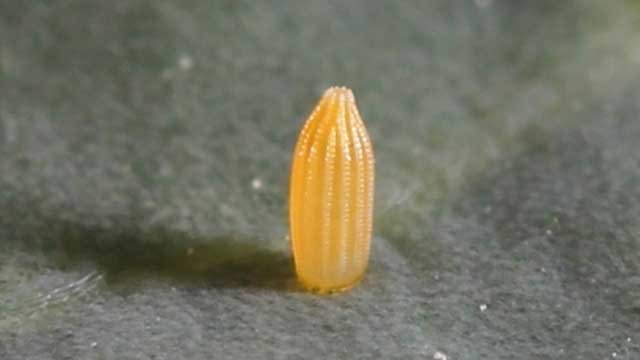
Pieris rapae egg – Alpsdake, CC BY-SA 3.0, via Wikimedia Commons
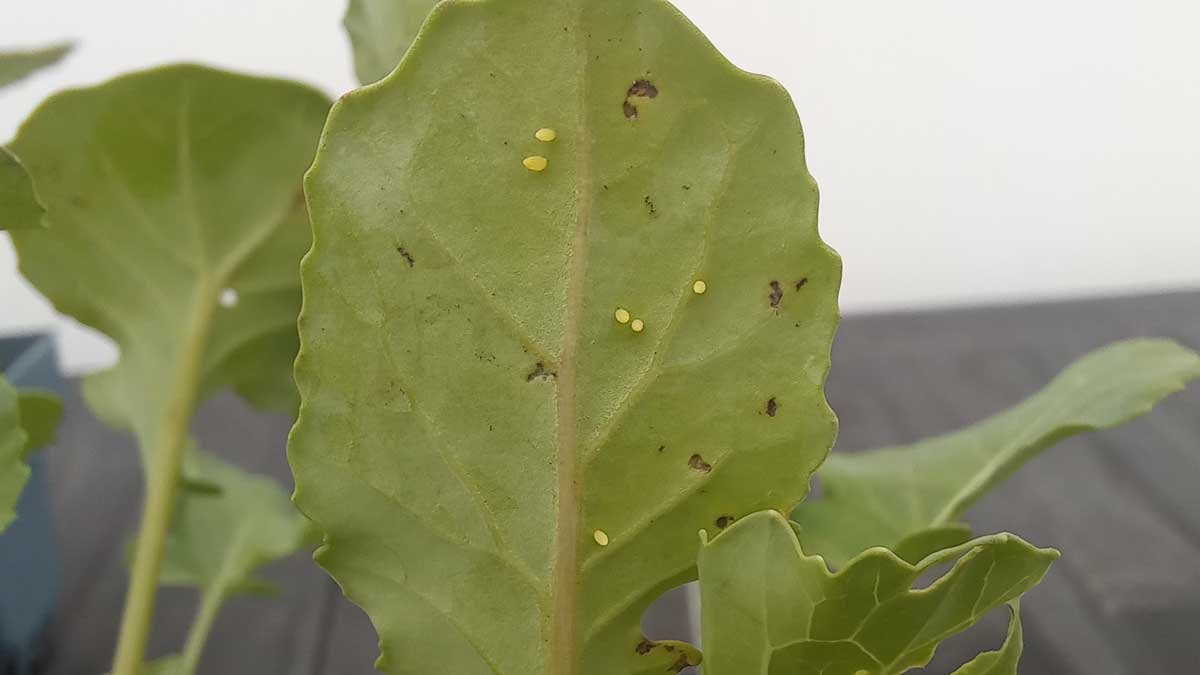
White cabbage butterfly eggs on seedlings I purchased in March.
Each egg is laid by itself (rather than in a group), and will take 8 to 10 days to hatch.
The egg is white when it is laid, but the colour deepens to yellow as it gets closer to hatching.
Female white cabbage butterflies are capable of laying up to 400 eggs each!
After hatching, a baby caterpillar goes through five stages of growth – which are called ‘instars’.
Larval instars
These are the periods of growth – actually five of them – where the most damage occurs in your garden. You might know them as a green caterpillar.
The growth cycle at this stage is heavily dependent on temperature. Caterpillars don’t do well in temperatures below 10°C, or above 35°C. Temperatures above 40°C will pretty much kill them. Fastest growth occurs between 30°C and 35°C.
To begin with, the caterpillars are about 1.5mm long. They are a pale yellow-green with dark hairs.
At this stage, they won’t chew holes right through your leaves. Instead, they’ll feed on the surface tissue. Generally, you’ll find them on the underside of leaves, where they are less obvious to predators.
As the caterpillar matures, it sheds its exoskeleton (moults). This happens five times and signals the beginning of the next instar.
Each instar can be identified by the markings on its head. The Wikipedia article on Pieris rapae explains what each of these looks like, if that’s something you’re interested in.
As it matures, the caterpillar will migrate to the middle of the plant, and begin eating the flesh of the leaves between the midribs. This will leave your plant looking skeletal.
It takes 21 to 40 days for the caterpillars to mature to 20-30mm long. They will become long, fat, and dull green with a thin orange stripe down its back.
Pupation
The caterpillar will leave its host plant and go look for somewhere to pupate – perhaps on a nearby post or fence, or in some bushes.

The pupation stage typically takes 15 to 18 days, before emerging from its chrysalis as a white butterfly.
Sometimes a caterpillar may stay in this state over winter, emerging in spring instead. This is called ‘diapause’, and suspends all development of the pupa until conditions are more favourable.
Adult white cabbage butterfly
Females have two black spots on each forewing (the top wing), while males have one spot. Females also tend to be a little yellower.

Peiris rapae female adult (left) – Muséum de Toulouse, CC BY-SA 4.0, via Wikimedia Commons
Peiris rapae male adult (right) – Ypna, CC BY-SA 3.0, via Wikimedia Commons
Both have a single black spot on the lower wing. The average wingspan is 40-50mm.
Adult white cabbage butterflies that have emerged from an over-wintering diapause in spring are typically smaller with less-distinct spots than one which pupated over summer.
They are most active on bright, sunny days, and feed on flower nectar, preferring purple, blue, and yellow flowers.
They can fly up to 12km at a time. Females are more likely to travel widely, while males tend to hang about host plants waiting for a female to show up.
Females lay most of their eggs in the first week of their adult life; and die after about three weeks as a butterfly.
Favourite foods
The white cabbage butterfly isn’t limited to cabbages, but it does prefer the family of plants cabbages come from: brassica.
Common brassica plants in your garden might include:
- Arugula / rocket
- Bok choi
- Broccoli
- Brussels sprouts
- Cabbage
- Cauliflower
- Chinese cabbage
- Collard greens
- Gai lan
- Kale
- Kohl rabi
- Mustards
- Pak choi
- Radish
Other host-plants that might be near your garden include:
- Alyssum (Lobularia maritima)
- Cresses
- Nasturtium (Tropaeolum spp.)
- Shepherd’s purse (Capsella bursa-pastoris)
- Stock (Matthiola incana)
You can use this knowledge to set a ‘trap crop’ away from your garden and lure butterflies to less-productive plants, such as nasturtium.
Predators
Even though the white cabbage butterfly is not native to New Zealand, many of their natural predators have been introduced alongside them.
Harnessing natural predators saves you a job – and improves the ecosystem overall.
The major problem is while a white cabbage butterfly is a caterpillar, it’s essentially the same colour as the leaves it lives on. This camouflages them, and means the caterpillars are categorised as ‘cryptic’ – able to avoid being spotted by their predators.
Birds and generalist predators
Many introduced birds will enjoy a caterpillar snack. There are also bugs that predate other bugs.
Birds and predators will help you by eating white cabbage butterfly throughout their lifecycle.
These helpful species include:
- Fantail / pīwakawaka
- Goldfinch
- Ladybug
- Paper wasp
- Sparrow
- Spiders
- Skylark
- Thrush
Parasitic wasps
Parasitic wasps lay their eggs inside living caterpillars. When the eggs hatch, their first meal is helpfully right there! Another name for these wasps is ‘beneficial insects’.
The three species you want to be familiar with – and encourage – in your garden are Pteromalus puparum (White Butterfly Pupal Parasite), Echthromorpha intricatoria (White-spotted Ichneumonid Wasp), and Cotesia glomerata, (White Butterfly Parasite).

Pteromalus puparum (Linnaeus, 1758) (left) – Natural History Museum – CC BY 2.0, via Flikr
Echthromorpha intricatoria (right) – Flossiepip, CC BY 4.0, via iNaturalist
Pteromalus puparum was introduced to New Zealand following the white cabbage butterfly’s arrival between 1930 and 1934.
Adults are 3-4 mm long and feed on the nectar of flowers. Females are a shiny black, and males are a metallic greenish bronze. They fly short distances of less than 25 mm which makes them look like they’re hopping.
- READ MORE: Wasp (White butterfly pupal parasite) Pteromalus puparum (CitiSciHub.nz)
It is thought the white-spotted ichneumonid wasp was self-introduced from Australia. They have a wingspan of about 30mm, and a body length of about 15mm.
They do not sting and are mostly solitary. White-spotted ichneumonid wasps prefer to inject the caterpillars with eggs while they are pupating.
Cotesia glomerata, (White Butterfly Parasite – shown on the right) was also introduced to New Zealand in the 1930’s to help keep white cabbage butterfly population in check.
Adults are black, with two sets of wings, and typically 3-7mm in length. Adults lay eggs in white cabbage butterfly pupae and larvae eat the caterpillar before emerging and creating their own cocoons, emerging as adults after 7 to 10 days.
- READ MORE: Be Cabbage White Butterfly Free! (Ediblebackyard.co.nz)
- READ MORE: A Planting Plan to Entice the Beneficial Insects (Ediblebackyard.co.nz)
Control
Now we’ve learned about white cabbage butterfly, it’s time to think about how we control them.
To begin with, we’re going to look at non-chemical ways to do this. These might be things you haven’t thought of or tried.
Then we’ll run over the chemical controls that are available to you.
Weak point in the lifecycle
There is a weak point in the lifecycle of a white cabbage butterfly. Did you notice it? A point where you can concentrate your efforts to reduce numbers.
Normally, we focus on killing caterpillars in one way or another. By then, the horse (so to speak), has bolted.
We’ve just learned it takes at least 8 days for an egg to hatch. Those eggs are almost always laid on the underside of brassica leaves.
That means you can check the underside of your brassica leaves once a week, flick, squash, or hose off the eggs, and vastly reduce your pest load.
The real damage happens in the caterpillar (instar) stages. The butterflies themselves don’t cause damage at all.
Preventing the egg from hatching crushes the lifecycle entirely, and you now know exactly where to look.
Weather and climate
It’s been shown that the weather and climate has an impact on the lifecycle of a white cabbage butterfly.
Heavy winds can knock eggs off the leaves they have been deposited on. And heavy rains can drown caterpillars.
High temperatures (above 35°C) will also kill them. Low temperatures (below 10°C) will cause them to pupate longer until temperatures rise again.
You can use the low-temperature period to your advantage and grow your brassica crops over winter when caterpillars are not active.
Soil health
Healthy soils produce healthy plants. Healthy plants have a higher nutritional density.
Studies have shown that when a caterpillar eats from a healthy plant with high nutritional density, it will eat less, and grow faster.
That means much less damage to your plants. The caterpillar goes off to continue their lifecycle and you are able to share your garden without losing your crops.
You don’t need to do anything at all to the ‘pests’ – instead they just become part of your ecosystem. See my Deep Dive into Improving Soils Organically for tips on how to improve your soil’s health.
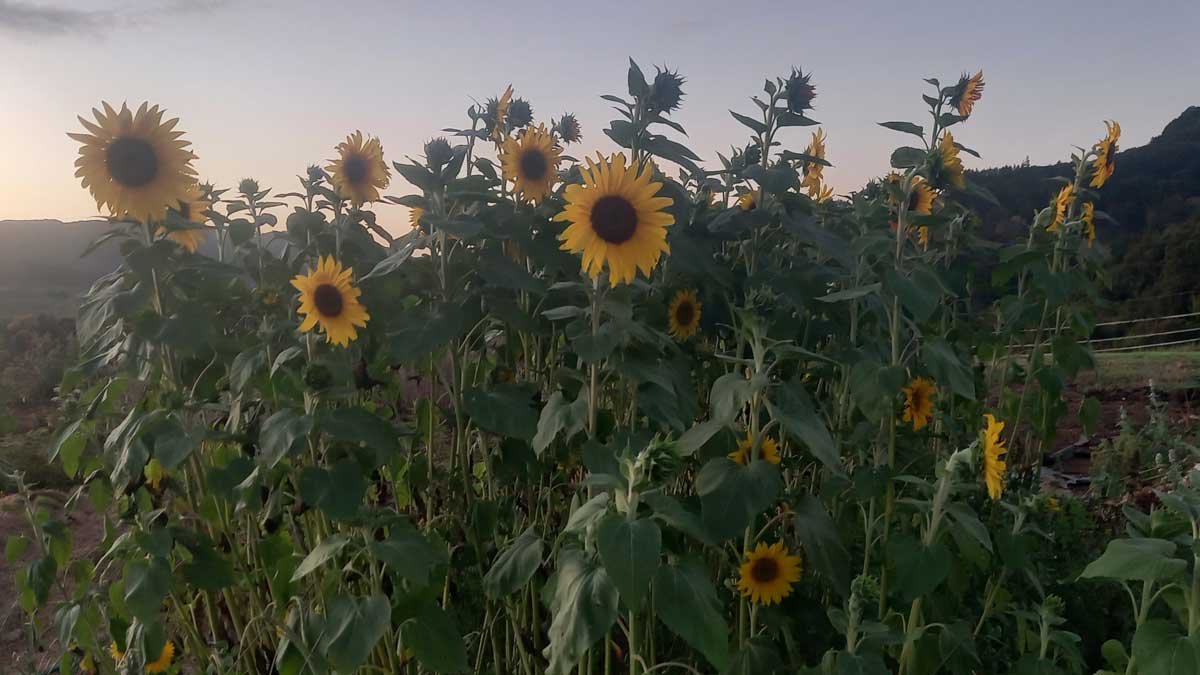
Improving soils organically
A deep dive into everything you need to know about your garden’s soils and improving them naturally.
Deterrents
Some plants are believed to act as deterrents. White cabbage butterflies don’t like them. Planting them near – or in – your garden might help prevent eggs being laid at all.
Some plants that are reportedly deterrents include:
- Chamomile
- Dill
- Hyssop
- Lavender
- Marigolds
- Mint
- Rosemary
- Sage
- Southernwood
- Tansy
- Thyme
Some gardeners swear by dried, crushed eggshells on the ground around their brassica plants.
They believe the sharp shells prevent caterpillars who have fallen off the plant from climbing back up.
Trap crops
Look again at the non-vegetable crops that white cabbage butterfly prefer:
- Alyssum (Lobularia maritima)
- Cresses
- Nasturtium
- Shepherd’s purse (Capsella bursa-pastoris)
- Stock (Matthiola incana)
You can set a ‘trap crop’ away from your garden and lure butterflies to less-productive plants, such as a nasturtium near your compost bin. Or alyssum near your front door.
Cut back regularly and throw in the compost to keep your pest levels down.
Physical covers
A bug net prevents white cabbage butterflies from laying eggs in the first place. This is usually my preferred method of control.
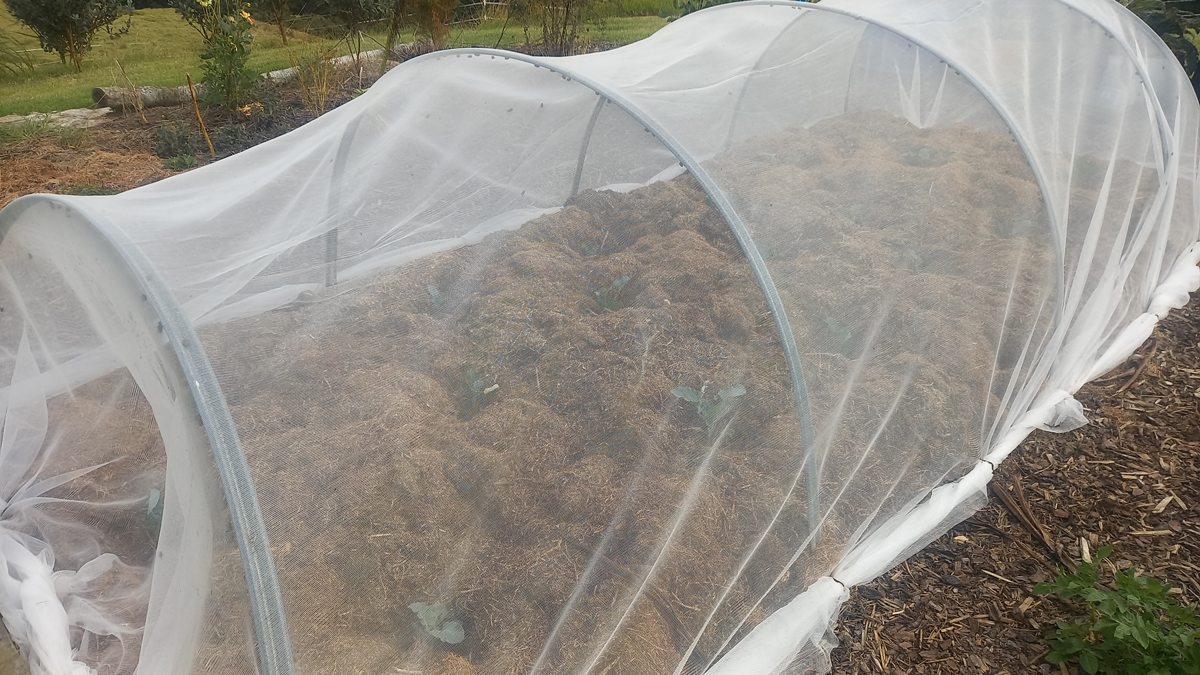
A range of bug net options exist. They can be purchased in sections, or in rolls from a range of suppliers. They have a very fine mesh which allows water and air to pass through, but prevents insects from getting near your plants.
The cheaper the bug net is, the less likely it is to withstand the weather New Zealand will probably throw at it. It’s worth buying one or two of the more expensive pieces and protect what’s important – Cosio is a good brand.
Make sure your bug net is properly secured – we’ve found burying it under soil is helpful for preventing gaps. Drape it over some cloches or another structure to keep your plants safe.
Decoys
Some growers have had success by making white plastic decoy butterflies from plastic containers.
The decoys are placed throughout their garden, and growers report that the real butterflies turn around as soon as they see them!
The flowers of the poached egg plant (Limnanthes) also look a little like butterflies. Some growers report it can also act as a decoy, preventing real butterflies from landing and laying eggs.
Home-made sprays
Some gardeners report success using a range of items commonly found in the garden or kitchen. Common ingredients in these sprays include:
Garlic – garlic is generally known to be a deterrent due to its odour. Blend 2 cloves of garlic with half a cup of warm water and allow to sit overnight.
Strain, then mix with 1 litre of water and 1 teaspoon of non-detergent soap. Spray on and around plants. Mix with chili to increase the effectiveness.
Chili – like garlic, chili is more of a deterrent. You can use whole fresh chili, dried flakes, or chili powder. The ingredient that makes chili hot – capsaicin – will send your caterpillars packing.
Follow the instructions for garlic, replacing the garlic with 1 tablespoon of chili for 1 litre of spray. Or keep the garlic and add the chili additionally.
Non-detergent soap – you’re really looking for Dr Bronner’s soap here, rather than dishwashing liquid or hand soaps.
Soaps are useful in sprays because they help the spray stick to the plant. This makes them more effective for longer. Add 1 teaspoon per litre to any other spray listed here.
Vegetable oil – similar to soap, oils help sprays stick to plants. They also help to smother insects that breath through their skin.
Simply add 1 tablespoon of vegetable oil per litre of water to any of the above sprays.
Diatomaceous earth
Diatomaceous earth is a powder made from crushed fossils. The edges of each grain of diatomaceous earth are very sharp, and are thought to both dehydrate and destroy insect skin.
Mix 1 tablespoon per litre of water, shake until dissolved, and spray onto your plants. When it dries it will leave a powdery residue. Or, simply sprinkle the powder around the base of your plants.
It will need to be reapplied following rain. Be careful not to breathe diatomaceous earth when handling. Rinse your sprayer thoroughly immediately after use.
Commercial controls
Organic sprays are still pesticides. They are usually derived from bacteria or plants and don’t care if the bug they’re killing is ‘good’ or ‘bad’.
Even using organic pesticide sprays can impact the beneficial species in your garden.
So take care when using these suggestions. But if all the above doesn’t work for you and you want a faster solution, these are probably the best places to begin.
This is not an exhaustive list of everything that’s available for caterpillar control, but it covers some of the most common active ingredients used by gardeners and horticulturalists.
Bacillus thuringiensis (BT)
This powder is mixed with water, and is actually a soil bacteria. When the bacteria is ingested by any caterpillar, it makes their guts explode.
It’s very effective as long as you re-spray after rain. We know from learning about the lifecycle of white cabbage butterfly that spraying under the leaves will be most important.
BT can be difficult to track down as a home gardener in New Zealand. Your best bet is to go to a farm store such as PGG Wrightson or Farmlands. Check the pesticides for products designed to attack caterpillars. Look for the active ingredient Bacillus thuringiensis. It is sold under a few brand names, and it might pay to ask a staff member.
You’ll be looking at about $100 for 1kg. That’s gonna last a home gardener decades. Smaller packs no longer seem to be available. It will store well in a sealed jar or container in a cool dark place. You can always split a packet with some friends.
Be aware Bacillus thuringiensis will work against all caterpillars – so don’t spray it on your swan plants or nettles!
Neem oil
Derived from the seeds of the Neem tree (Azadirachta indica), neem oil is highly insecticidal. The active ingredient is called Azadirachtin A.
Neem oil works when it is ingested, and is most effective against leaf-chewing and sap-sucking insects. That makes it a little safer to beneficial insects who tend to eat flower nectars. Azadirachtin A is known to be an eye and skin irritant, and it is very toxic to fish.
As an oil, it will pay to spray mostly in the evenings. This will mean it takes effect overnight (avoiding any bees), and dry with the dew in the morning. Applying any oil-based spray in bright daylight will risk burning the leaves of your plant.
Neem oil is available at most garden centres and is mixed with water before application.
Spinetoram
An active ingredient derived from soil bacteria Saccharopolyspora spinosa. It is highly insecticidal, working both by contact on the unwanted insect, and through ingestion. It works to kill the insects through overstimulation of their nervous system.
When sprayed on plants, spinetoram is able to travel through the leaf, meaning it can be sprayed on the tops of the leaves only and still be effective on the caterpillars hiding below.
This chemical is also used as a lice medication for humans, and as a flea treatment in cats. It is generally safer for aquatic life than alternatives, but is highly effective at killing bees on contact.
It is probably best sprayed in the evenings after bees have returned to their hives. Avoid spraying flowers.
Spinetoram is available in New Zealand garden centres as “Yates Success Ultra”.
Pyrethrum
Derived from the Dalmatian chrysanthemum daisy (Tanacetum cinerariifolium, formerly Pyrethrum cinerariifolium). Again, this is another highly insecticidal compound. It will also kill any insect that comes in contact with it.
The flowers contain six insecticidal and insect-repellent compounds called the pyrethrins, which affect an insect’s nervous system, and lead to their paralysis and death. It’s a general insecticide, and will affect beneficials and bees as well.
Pyrethrum sprays is available at most garden centres. It is typically sold in pre-mixed sprays, though concentrates are also available.
Derris dust
Derived from the South American plant, Derris eliptica. The active ingredient, rotenone, is a broad-spectrum insecticide.
Derris dust is a powder designed to be sprinkled on your plants about once a week. It carries risks to humans if it gets into your eyes or lungs.
Do not use this product on windy days where dust may get blown off and end up in waterways. Or on rainy days where it may be washed off into waterways. Wear both eye protection and a mask.
Derris dust is banned in the EU, and UK. In the USA it is only permitted for poisoning fish.
I’d recommend you try any of the previous products ahead of this one if I’m honest. It’s really bad news if it gets into drains and waterways.
Citizen science
That pest in your garden might be interesting to science. The Peiris Project collects butterflies and analyses their DNA to figure out how organisms adapt and change to new environments.
They chose to study the white cabbage butterfly because it has become widespread throughout the world due to human activity.
To participate, catch some butterflies, freeze them overnight to kill them, place them in a crush-proof container, and send them in the post to the Californian address published on their website.
The website specifically says it’s OK to send them from New Zealand.
Learn how to collect butterflies and participate in The Peiris Project.
What do you think?
Are you buying your kids badminton raquets this Christmas? Will you use derris dust ever again?
Have you seen those little green dickheads munching away on a plant I didn’t mention?
Leave a comment. If you made it this far then I’d definitely like to know what you think.

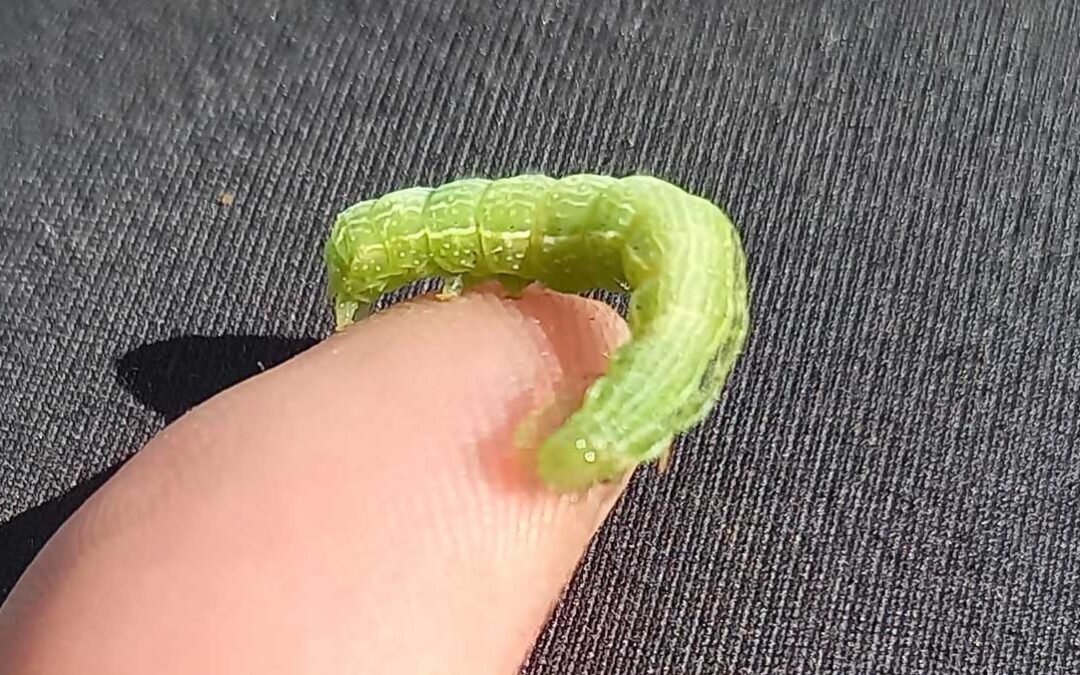

Ughhhh….. such a pretty little butterfly, such a nasty caterpillar! I didn’t get around to netting my Brussels sprouts son enough. So sad. Spent too much time squishing them. Hope the sprouts recover. Our days are growing shorter and cooler, I suspect I won’t get anything edible. 😢
Have you tried the garlic and/or chili spray? It’s more of a repellant, but it might help hose them off and give the plants a chance. Netting is definitely the way to go with the plantings heading toward autumn – in my garden I do it the day the seedlings are planted.